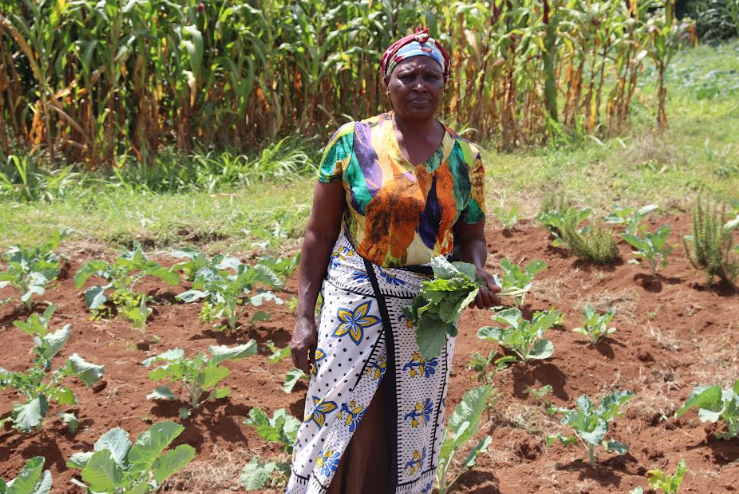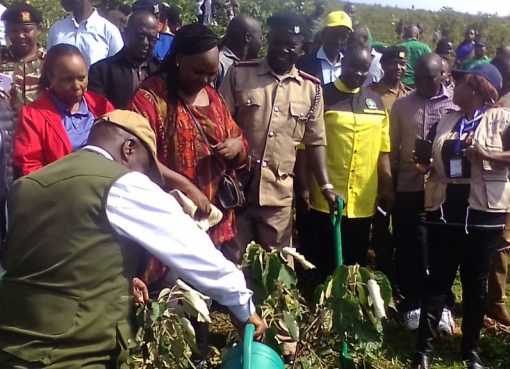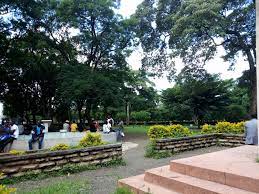It is minutes to noon when we embark on a journey from a vibrant trade of consumer goods in Kangari town to Mariira village in Kigumo Sub-county, Murang’a County tens of kilometers away.
We drive through a road characterized by hills, rivers and valleys which play a critical role in agricultural activities.
We are met by one John Ndirangu, a small-scale farmer who uprooted napier grass from a section of his farm and opted to grow kales (Sukuma wiki) and other types of vegetables in a quest to meet the nutrition needs of his family.
His home is located up a small hill where we climb a few meters on foot through a rough road leaving a trail of dust in our wake.
Ndirangu, 62, is just about to leave for his farm to get some kales from his piece of land to be used to prepare lunch for his family.
After brief introductions, he leads us to his farm about 100 meters away from his home compound.

His farm is about 1.4 hectares and is divided into potions where he farms tea, maize, kales, vegetables, onions, rosemary, coriander as well as he keeps some livestock and poultry.
Ndirangu, a retired teacher and a father of three attributes the healthy produce of kales and other types of vegetables in his farm to a new technology introduced to him by extension officers from International Center of Insect Physiology and Ecology (icipe) dubbed vegetable push pull technology under the AGROVEG project, in 2024.
AGROVEG stands for Intensified Agroecological-based cropping systems to enhance food security, environmental safety and income of smallholder producers of crucifers and traditional African vegetables in East Africa.
He says after receiving information about the importance of consuming healthy vegetables he was convinced to try out the technology.
He decides to uproot some napier grass from his portion of 100m by 100 m piece of land to practice the technology which has since proven to be a good decision for his family.
“Last year, an icipe worker came to talk to my wife and I about implementing a vegetable push– pull technology in our farm to control pests and disease in our farm and also to produce nutritious kales and other types of vegetables” says Ndirangu.
“At my old age, I should start taking care of my health and that of my family as cases of non-communicable diseases e.g., cancer is on the rise” he says with a smile on his face adding that healthy eating starts from how you farm your crops.
In his three-part portion farm, he is inter-cropping kales with onions in one portion, kales and rosemary in another potion and lastly kale with coriander.
“I don’t have any major pest control challenges since I am using the new technology in my garden which is a natural way of pest management” he said.
The vegetable push pull technology introduced to him is an agro ecological innovation that farmers use to manage pests and diseases within inter-cropping systems without the use of chemicals.
A research Report by Route to Food Initiative on Toxic Business Highly Hazardous Pesticides in Kenya revealed that pesticides exceeding standardized limits have been found in Kenyan foods, particularly in kales and tomatoes
Data shows that during the reporting period of 2020 farmers in Kenya used a total of 310 pesticides products and out of which 195 products (63 percent) contained one or two active ingredients that are categorized as highly hazardous pesticides.
Notably almost half (44 percent) of the total volume of pesticides used are already banned in Europe due to their unacceptable risk to human health and the environment.
Ndirangu explains planting kales and other types of vegetables in his farm also significantly reduces the cost of money he uses daily to buy the vegetable and it provides a regular supply of vegetables for his family.
“I used to buy kales for Sh. 200 every week for my family consumption. But since I decided to have my vegetable garden, that money I save and use to pay school fees for my son who is studying at a local technical university” he said.
He also says that technology has improved the soil fertility and made the soil “lighter”, and so easier to work on.
Dr. Edward Karanja an Agriculture and Climate Change Theme Scientist at icipe says that the principle for the vegetable push pull technology is the same as the conventional push pull technology used for maize and other cereals but the only change was on the crops that are acting as a ‘push’ crop and those that are acting as a ‘pull’ crop.
“We have a conventional push pull system that works for maize and other cereal crops such as babycorn against fall armyworm and stemborer pests.” He says adding that in this setup, desmodium crop is used as a push crop and brachiaria as a pull crop
Karanja divulges the conventional push pull technology has been modified and adopted to suit other crops that farmers are growing like kales and other types of traditional vegetables that also face pest and diseases challenges.
Kales (Brassica oleracea ) is a leafy vegetable of global importance, primarily cultivated by small scale farmers for both substance and income generation.
According to Center for Disease Control (CDC) kale is ranked 15th of the 47 powerhouse fruits and vegetables, producing more than 17 essential nutrients that have been linked to reduced risk of cancer and other chronic diseases due to antioxidant properties and high dietary fiber content.
The scientist observes most vegetable growers in Murang’a County are mainly smallholder farmers who often lack access to effective and ecologically sound pest and disease control tools, for healthy and sustainable vegetable production systems.
“Farmers rely heavily on synthetic insecticides to control pests leading to pesticide residue contaminations, development of pesticide resistance and elimination of natural enemies in the farms” he says.
A Research published by icipe in 2024 for Vegetable push-pull Cropping System necessitates for sustainable alternatives to mitigate pests like cabbage aphid (brevicoryne brassicae), a major pest of kale.
The research assessed behavioral responses of cabbage aphids to odours from rosemary (Rosmarinus officinalis) and kales.
The findings demonstrate the potential of rosemary as a repellent plant against cabbage aphids and could be utilized as a ‘push ‘crop in an intercropping strategy against pest.
Karanja says the new technology can also control pests by intercropping kales with either rosemary, spring onions, coriander or mint which act as push and pull crops.
He states the conventional push pull where the pull crops were not used as food by the farmer, in the vegetable push pull technology, all the crops used in the system can be used by the farmer as food.
He adds the technology can reduce input costs for the farmers and chemical residues in our foods and the environment and improve farm productivity and profitability.
Murang’a and Kiambu counties are the two counties benefiting from the AGROVEG project in Kenya. The other benefiting country in Africa is Tanzania, Arusha region.
The AGROVEG project is funded by the Biovision Foundation and the lead implementing organization is icipe together with other partners including World Vegetable, SysCom Kenya, FiBL and Ministry of Agriculture.
According to AGROVEG project coordinator Dr. Daniel Mutyambai, the beneficiaries of the project will benefit from reduced vegetable damage by pests, hence increasing vegetable productivity and marketability.
“The project purpose is to improve productivity of agro ecological based vegetable cropping systems through bio- intensive approaches like vegetable push pull technology.” he opines.
Mutyambai says the project targets directly to improve food and nutrition security for over 3,232 farm households with available and affordable African vegetables with at least 60 percent women involved from production to market.
“Women are the major producers of horticultural crops, mainly traditional African Vegetables and other leafy vegetables, and will immensely benefit from this initiative” he says.
He says the project is expected to reach 42,300, vegetables producers indirectly, as well as consumers and government authorities, and enhance food security, environmental safety and income generation of smallholder vegetable producers through agro ecological based cropping systems.
“The technology offers a method of tackling pests and diseases using other living organisms and naturally-sourced compounds, such as insect predators and parasitoids” says Mutyambai.
The Coordinator divulges that apart from pest management, additional benefits of the technology include improvement of soil health, enhanced farm biodiversity and improved income because the farmer has additional alternative crops like rosemary, coriander, which can be used as food or sold to earn extra coin.
Njeri Chege, 63 years old, a farmer from Kangari village is another beneficiary of the AGROVEG project.
The mother of four uses a portion of her farm to grow kales, spinach, cabbage and other vegetables.
She has intercropped kales with spinach on one potion and in another section she has planted kales intercropped with coriander.
The good yields encourage her to also integrate green leafy onions on a second parcel of farm. She uses the coriander and rosemary intercropped in the garden as spices and herbs respectively.
“Some of the kales, onions and coriander are eaten at home, thereby improving the family’s nutritional status, some are sold to the nearby market in Kangari town” she says.
“The technology produces better yields and is healthier than the ones she used to grow, which were attacked by cabbage looper, aphids, and diamondback moth,” she said.
Agriculture is the backbone to Murang’a County’s economy and therefore the need to continuously seek to end hunger, achieve sustainable food security and improve nutrition in line with SDG 2.
Over 80 percent of the households in the county depend on agriculture and related activities.
Murang’a County Government recognizes the important role agro ecological approaches can play in transforming agriculture and food systems.
The County has established Murang’a Agroecology Policy 2022-2032 and the Murang’a County Agroecology Development Act, 2022 to provide a framework for progressive agricultural growth, development and transform agriculture into a sustainable and viable sector.
Murang’a County Deputy Governor Stephen Munania speaking during the launch of the Policy in 2023 said that by enacting the Policy and Act they are showing concern for the people of Murang’a since it will be of importance in encouraging farmers to grow healthy crops for nutritious benefits.
“The enactment of the two legislations has placed the county among the leading actors committed to developing favorable legal frameworks for guiding the implementation of agro ecology”, says Munania.
Agro ecology farming is a kind of farming that small scale farmers, mostly women in Murang’a County, have embraced in droves.
Agroecology farming seeks to reduce reliance on chemical inputs, enhance soil fertility and increase biodiversity.
Janet Nyambura, who hails from Mathanji-ini village in Kangari, is an organic farmer who is reaping big from organic vegetable farming.
Nyambura is part of a women’s group called Kangari Organic Farmers KOFAM that has thirty members who practice organic farming and are certified on selling organic herbs and also vegetables.

The group has a designated area within Kangari market where they sell organic products through the help of Murang’a county government.
Nyambura has for several years been farming vegetables at a small-scale level for her family consumption and also for sale in her village at the nearby Kangari market.
Agro ecological practices also include production of compost manure to boost yields. She has been making her own compost from available products on the farm.
Biovision Africa Trust organization works with smallholder farmers in Murang’a by educating and training them on agroecology practices and knowledge.
Biovision Africa Trust officer Sarah Karanja based in Maragua town says that they have been working with over 200 farmers who mostly are in groups to scale up agroecology uptake in the area.
“We reach farmers with agroecology information through outreach programs, the organic farmer magazine, Infonet website and outreaches through group training, field days, demo farms and individual farm visits” she says.
She continues, “We have trained our farmers to use technology innovations like push and pull on their farms for integrated pest management.”
The officer adds the adoption is high and the farmers are very positive about push and pull technology.
By Anita Omwenga




